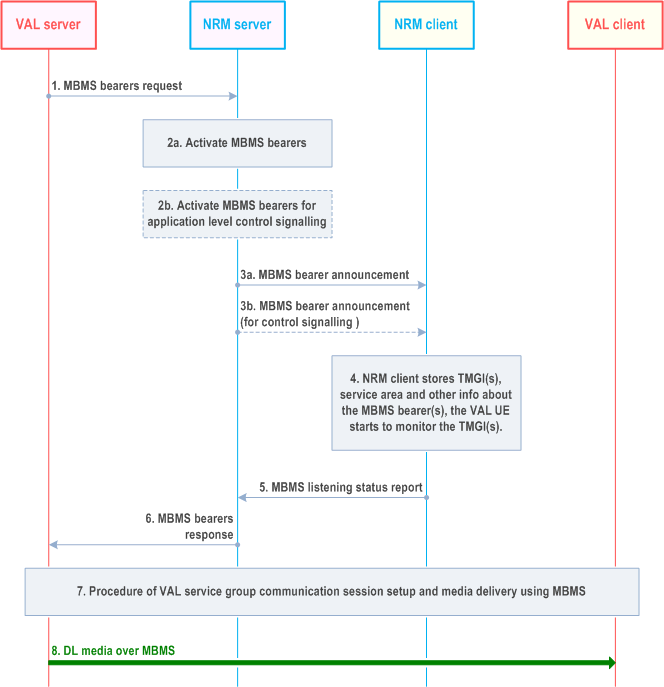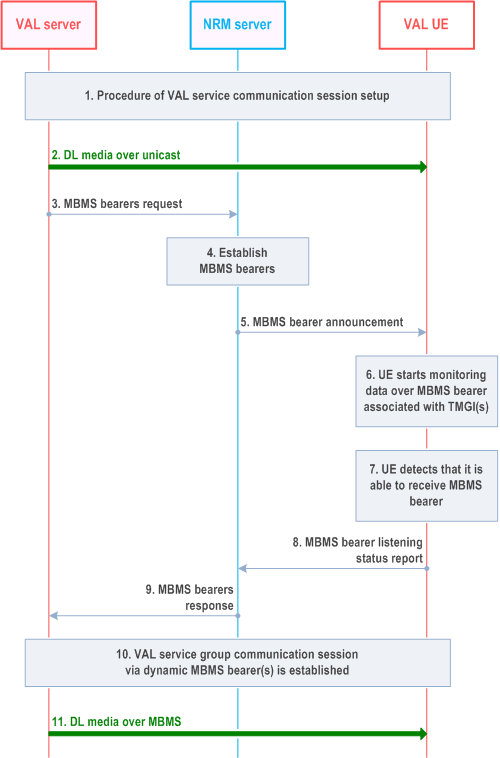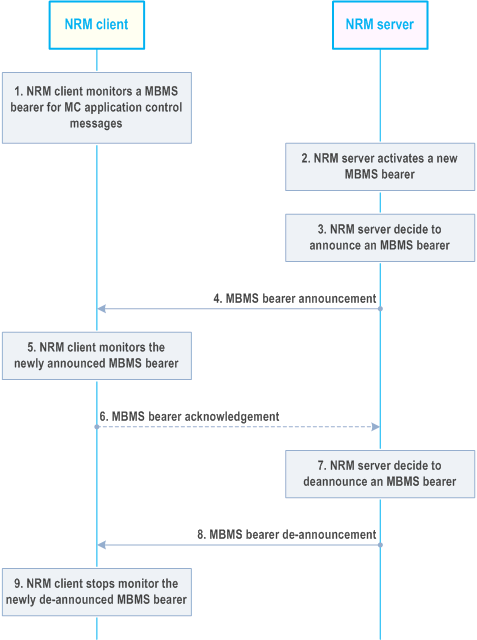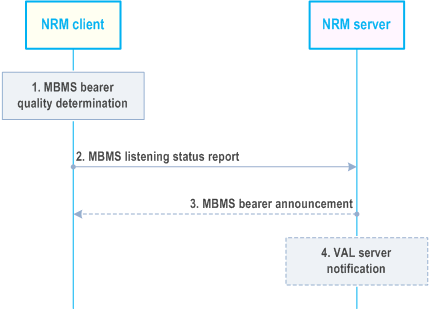Content for TS 23.434 Word version: 19.2.0
0…
4…
5
6…
6.4…
6.5…
6.5.3…
7…
8…
8.2.2…
9…
9.3…
9.3.2.21…
9.3.3…
9.3.6…
9.3.11…
9.3.13…
9.3.14…
9.4…
9.4.6…
9.5…
10…
10.3…
10.3.2.22…
10.3.3…
10.3.7…
10.3.10…
10.4…
11…
11.3…
11.3.3…
11.4…
12…
12.3…
13…
14…
14.2.2.2…
14.3…
14.3.2.20…
14.3.2.40…
14.3.3…
14.3.3.3…
14.3.4…
14.3.4.6
14.3.4.7…
14.3.4A…
14.3.4A.3…
14.3.4A.4…
14.3.4A.6…
14.3.4A.8…
14.3.4A.9…
14.3.4A.10…
14.3.5…
14.3.6…
14.3.9…
14.3.12…
14.4…
15…
16…
17…
18…
A
B…
14.3.4 Multicast resource management for EPS
14.3.4.1 General
14.3.4.2 Use of pre-established MBMS bearers
14.3.4.3 Use of dynamic MBMS bearer establishment
14.3.4.4 MBMS bearer announcement over MBMS bearer
14.3.4.5 MBMS bearer quality detection
...
...
14.3.4 Multicast resource management for EPS p. 202
14.3.4.1 General p. 202
The VAL server utilizes the NRM server for multicast resource management.
To activate the multicast bearers in the EPS, the NRM server shall use the Activate MBMS Bearer procedure specified in TS 23.468 with the NRM server performing the GCS AS function.
To deactivate the multicast bearers in the EPS, the NRM server shall use the Deactivate MBMS Bearer procedure specified in TS 23.468 with the NRM server performing the GCS AS function.
To modify multicast bearers in the EPS, the NRM server shall use the Modify MBMS Bearer procedure specified in TS 23.468 with the NRM server performing the GCS AS function.
14.3.4.2 Use of pre-established MBMS bearers p. 202
14.3.4.2.1 General p. 202
In this scenario, upon triggered by VAL server, the NRM server pre-establishes MBMS bearer(s) in certain pre-configured areas before the initiation of the VAL service group communication session. When a user originates a request for a VAL service group communication session for one of these areas, the pre-established MBMS bearer(s) is used for the DL VAL service communication.
The following steps need to be performed prior to the start of the VAL service group communication session over pre-established MBMS bearer:
- Pre-establish MBMS bearer(s)
- Announce the pre-established MBMS bearer to the NRM clients
14.3.4.2.2 Procedure p. 203
The procedure Figure 14.3.4.2.2-1 shows only one of the receiving VAL clients using an MBMS bearer. There might also be VAL clients in the same VAL service group communication session that receive the communication on unicast bearers.

Step 1.
The VAL server sends a MBMS bearers request to the NRM server including service description(s) for which the MBMS bearers are requested.
Step 2a.
The NRM server determines to activate MBMS bearer. The activation of the MBMS bearer in EPS is done on the MB2-C reference point and according to TS 23.468. This bearer will be used for the VAL service communication. If local MBMS is requested in step 1, the NRM server uses the local MBMS information provided by VAL server in step 1 or the local MBMS information configured locally in the NRM server to activate the MBMS bearers. The NRM server performs local MBMS procedures in line with the procedure of L.MBMS based MBMS data delivery defined in TS 23.285.
Step 2b.
Optionally, the NRM server may also activate an MBMS bearer dedicated for application level control signalling. The activation of the MBMS bearer is done on MB2-C reference point and according to TS 23.468. If local MBMS is requested in step 1, the NRM server uses the local MBMS information provided by VAL server in step 1 or the local MBMS information configured locally in the NRM server to activate the MBMS bearers. The NRM server performs local MBMS procedures in line with the procedure of L.MBMS based MBMS data delivery defined in TS 23.285.
Step 3a.
The NRM server passes the MBMS bearer info for the service description associated with the pre-established MBMS bearer to the NRM client. The NRM client obtains the TMGI, identifying the MBMS bearer, from the service description.
Step 3b.
The NRM server may pass the MBMS bearer info for the service description associated with the application control MBMS bearer to the NRM client. The NRM client obtains the TMGI, identifying the MBMS bearer, from the service description.
Step 4.
The NRM client stores the information associated with the TMGI(s). The NRM service client uses the TMGI and other MBMS bearer related information to activate the monitoring of the MBMS bearer by the VAL UE. The NRM client shares the MBMS bearer related information with the VAL client.
Step 5.
The NRM client that enters or is in the service area of at least one announced TMGI indicates to the NRM server that the VAL UE is able to receive VAL service communication over MBMS, whereby the NRM server may decide to use the MBMS bearer instead of unicast bearer for VAL service communication sessions based on available information at the NRM server including the MBMS listening status report as described in clause 14.3.4.5.
Step 6.
The NRM server provides a MBMS bearers response to the VAL server.
Step 7.
A VAL service group communication session is established.
Step 8.
As the VAL server transmits the VAL service communication over the MBMS bearer, the VAL service communication packets are detected and delivered to the VAL client.
14.3.4.3 Use of dynamic MBMS bearer establishment p. 204
14.3.4.3.1 General p. 204
In this scenario, the VAL server uses a unicast bearer for communication with the UE on the DL at the start of the group communication session. When the VAL server triggers to use an MBMS bearer in EPS for the DL VAL service communication, the NRM server decides to establish an MBMS bearer in EPS using the procedures defined in TS 23.468. The NRM server provides MBMS service description information associated with MBMS bearer(s), obtained from the BM-SC, to the UE. The UE starts using the MBMS bearer(s) to receive DL VAL service and stops using the unicast bearer for the DL VAL service communication.
14.3.4.3.2 Procedure p. 204
Figure 14.3.4.3.2-1 illustrates the use of dynamic MBMS bearer establishment.

Step 1.
A VAL service group communication session is established.
Step 2.
The downlink data is sent by unicast delivery.
Step 3.
The VAL server sends MBMS bearers request to the NRM server.
Step 4.
The NRM server establishes the MBMS bearer(s) for the VAL service group communication session according to the procedures defined in TS 23.468. Service description associated with the MBMS bearer(s) is returned from the BM-SC. If local MBMS is requested in step 3, the NRM server uses the local MBMS information provided by VAL server in step 3 or the local MBMS information configured locally in the NRM server to activate the MBMS bearers. The NRM server performs local MBMS procedures in line with the procedure of L.MBMS based MBMS data delivery defined in TS 23.285.
Step 5.
The NRM server provides service description information associated with the MBMS bearer to the UE. The VAL UE obtains the TMGI from the announcement message. This message may be sent on an application level control signalling bearer.
Step 6.
The VAL UE starts monitoring data over MBMS associated with the TMGI, while in the service area associated with the TMGI.
Step 7.
The VAL UE detects that it is able to receive data over MBMS associated with the TMGI.
Step 8.
The NRM client notifies the NRM server the MBMS listening status associated to the monitored TMGI, (e.g. that it is successfully receiving the TMGI). The NRM client may also notify the MBMS reception quality level of the TMGI. The NRM server may decide to use the MBMS bearer instead of unicast bearer for VAL service communication sessions based on available information at the NRM server including the MBMS listening status report as described in clause 14.3.4.5.
Step 9.
The NRM server provides an MBMS bearer response to the VAL server with the dynamic MBMS bearer(s) information. The VAL server stops sending VAL service communication data over unicast way to the VAL client.
Step 10.
A VAL service group communication session via dynamic MBMS bearer(s) is established.
Step 11.
The VAL server sends the downlink VAL service communication for the VAL service group communication session over the MBMS.
14.3.4.4 MBMS bearer announcement over MBMS bearer p. 206
14.3.4.4.1 General p. 206
The MBMS announcement may be done on either a unicast bearer or a MBMS bearer. Using a unicast bearer for MBMS bearer announcement provides an interactive way of doing announcement. The NRM server will send the MBMS bearer announcement message to the NRM client regardless if there is an MBMS bearer active or the VAL client can receive the data on the MBMS bearer with sufficient quality. The benefit of the existing procedure is that it gives a secure way to inform the NRM client about the MBMS bearer and how to retrieve the data on the MBMS bearer.
When there is more than one MBMS bearer active in the same service area for VAL service, there are not the same reasons to use unicast bearer for additional MBMS bearer announcement. Instead a MBMS bearer for application level control signalling can be used to announce additional MBMS bearers.
The MBMS bearer announcement messages are sent on an MBMS bearer used for application control messages. This bearer will have a different QoS setting compared to an MBMS bearer used for VAL service communication, since application signalling messages are more sensitive to packet loss.
14.3.4.4.2 Procedure p. 206
Figure 14.3.4.4.2-1 illustrates a procedure that enables the NRM server to announce a new MBMS bearer.
Pre-conditions:
- An MBMS bearer used for VAL service application control messages must have been pre-established and announced to the NRM client.
- Additional MBMS bearer information may have already been announced to the NRM client.

Step 1.
The same procedure can also be used to modify existing MBMS bearer announcement information. Example of such modification could be addition of UDP ports or modification of codec in the SDP.
The NRM client monitors an MBMS bearer that is used for VAL service application signalling messages, such as bearer announcement messages.
Step 2.
The NRM server activates a new MBMS bearer.
Step 3.
The NRM server announces the MBMS bearer to the NRM client. The bearer may have just been activated or may have already been running for some time. The step may be repeated as needed.
Step 4.
The NRM server sends a MBMS bearer announcement on the MBMS bearer used for VAL application control messages. The MBMS bearer announcement contains the identity of the MBMS bearer (i.e. the TMGI) and may optionally include additional information about the newly announced bearer. Required and optional MBMS bearer announcement details may have already been provided. In this case the MBMS bearer identity could be used as a key for such MBMS bearer details.
Step 5.
The NRM client start to monitor the newly announced MBMS bearer.
Step 6.
If requested by the NRM server, the NRM client sends an acknowledgement of the MBMS bearer to the NRM server.
Step 7.
The NRM server de-announce the MBMS bearer.
Step 8.
The NRM server sends a MBMS bearer de-announcement message that contains the identity of the MBMS bearer.
Step 9.
The NRM client stops monitoring the de-announced MBMS bearer.
14.3.4.5 MBMS bearer quality detection p. 208
14.3.4.5.1 General p. 208
The NRM client and NRM server use this procedure to report and take action on the MBMS bearer quality towards VAL service communications. A NRM client monitors an MBMS bearer to enable receiving VAL service communication. Based on the received quality (e.g. radio level quality, transport level quality), the NRM client needs to inform the NRM server that the VAL UE is able to receive the VAL service communication on the MBMS bearer with sufficient quality or not able to receive the VAL service communication on the MBMS bearer with sufficient quality. Furthermore, based on the received quality, the NRM client may notify the NRM server at which MBMS reception quality level it has received the VAL service communication on the MBMS bearer.
The issue can be more complex since the NRM client needs to estimate the quality of the bearer even in the scenario when there are no data currently transmitted on the MBMS bearer. The reason for this is that an NRM client that has entered an area with significantly degraded MBMS quality, might not even notice that a VAL service communication is ongoing, meanwhile the NRM server still assumes that the VAL UE can receive the VAL service communication being broadcasted.
To estimate the MBMS bearer quality, for example as an equivalent BLER (Block Error Rate), when no data is sent is implementation specific. This estimation can be dependent on for example the modulation and coding scheme (MCS) and measurements from the reference signals from the eNB(s). Other metrics (e.g. RTP packet loss) may be used to estimate the MBMS bearer quality.
Based on the MBMS bearer quality reported from the NRM clients, the NRM server may decide to use the MBMS bearer for a group communication if a certain number of NRM clients located in the MBMS service area are able to receive the VAL service communication. And if a NRM client is not able to receive the VAL service communication on the MBMS bearer, the NRM server may decide to switch the user plane deliver mode for the NRM client from MBMS bearer to unicast bearer.
14.3.4.5.2 Procedure p. 208
The NRM client shall indicate the ability of the NRM client to receive the MBMS bearer.
Pre-conditions:
- There is an MBMS bearer activated and the MBMS bearer information is announced to the NRM client
- The NRM client is located in the MBMS broadcasting area
- The VAL UE monitors SIB-13 (or SIB-20) and (SC-)MCCH to receive the modulation and coding scheme
- The VAL UE monitors the cell specific reference signal and when MBSFN transmission is used, the MBSFN specific reference signals

Step 1.
The NRM client determines that the MBMS bearer quality shall be reported to the NRM server. The NRM client may determine the MBMS bearer quality by using the BLER of the received data. When no data is received, the quality estimation can consider the reference signals and the modulation and coding scheme (MCS). The UE may also use predictive methods to estimate the expected MBMS bearer quality (e.g. speed and direction) to proactively inform the NRM server of an expected loss of the MBMS bearer quality. The NRM client may also map the determined MBMS bearer quality to a MBMS reception quality level. The MBMS reception quality level indicates at which specific MBMS bearer quality level the VAL service communication has been received.
Step 2.
If the MBMS bearer quality reaches a certain threshold, the NRM client sends an MBMS listening status report. The threshold is used to define the MBMS listening status, which indicates if the MBMS bearer quality has been acceptable or not to receive a specific VAL service communication. If the MBMS bearer quality is mapped to a different MBMS reception quality level, the NRM client may send an MBMS listening status report including the MBMS reception quality level. Based on the MBMS listening status, if MBMS reception quality level is received, then the NRM server may efficiently decide to switch to another bearer (e.g., MBMS bearer or unicast bearer) or to take measures to prepare such a switch and further notify the VAL server.
Step 3.
The NRM server may send additional proposal for measurements e.g. information about neighbouring MBMS bearers. This message may be an MBMS bearer announcement message.
Step 4.
The NRM server may send user plane delivery mode to VAL server based on the MBMS listening status to preserve the service continuity as described in clause 14.3.4.6 and clause 14.3.4.9.